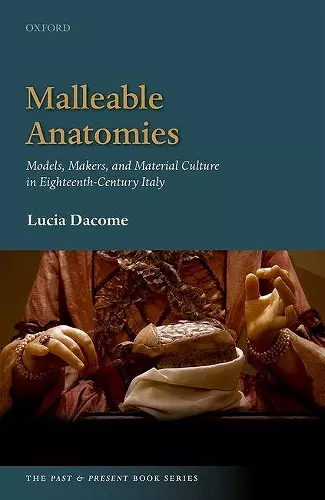Malleable Anatomies
Models, Makers, and Material Culture in Eighteenth-Century Italy
Format:Hardback
Publisher:Oxford University Press
Published:1st Jun '17
Currently unavailable, and unfortunately no date known when it will be back

Malleable Anatomies offers an account of the early stages of the practice of anatomical modelling in mid-eighteenth-century Italy. It investigates the 'mania' for anatomical displays that swept the Italian peninsula, and traces the fashioning of anatomical models as important social, cultural, and political as well as medical tools. Over the course of the eighteenth century, anatomical specimens offered particularly accurate insights into the inner body. Being coloured, soft, malleable, and often life-size, they promised to foster anatomical knowledge for different audiences in a delightful way. But how did anatomical models and preparations inscribe and mediate bodily knowledge? How did they change the way in which anatomical knowledge was created and communicated? And how did they affect the lives of those involved in their production, display, viewing, and handling? Examining the circumstances surrounding the creation and early viewing of anatomical displays in Bologna and Naples, Malleable Anatomies addresses these questions by reconstructing how anatomical modelling developed at the intersection of medical discourse, religious ritual, antiquarian and artistic cultures, and Grand Tour display. While doing so, it investigates the development of anatomical modelling in the context of the diverse worlds of visual and material practices that characterized the representation and display of the body in mid-eighteenth-century Italy. Drawing attention to the artisanal dimension of anatomical practice, and to the role of women as both makers and users of anatomical models, it considers how anatomical specimens lay at the centre of a composite world of social interactions, which led to the fashioning of modellers as anatomical celebrities. Moreover, it examines how anatomical displays transformed the proverbially gruesome practice of anatomy into an enthralling experience that engaged audiences' senses.
[A] superb work... Highly recommended. * CHOICE *
...the volume is rich and important. Focusing more on the lives of wax modellers than on that of the anatomical waxes (which could be a choice), it broadens the horizon on the relationships between art, science, gender and patronage in the eighteenth century. * Francesco Paolo de Ceglia, European History Quarterly *
This is an important book, dealing with eighteenth-century Italian anatomical models and displays, especially those made in wax, in Bologna, with a coda on Southern Italy, on Naples and Palermo ... This is a timely and useful book, offering a nuanced assessment of anatomy and surgery, medicine and science, while also providing an enlightening and at times unexpected perspective on Italian history in the Settecento. * Maria Conforti, Metascience *
demonstrates the continuing power of richly contextualized local case studies. Dacome's analysis brings together a wide range of approaches: by tracing the models and their materiality she finds new ways of understanding contemporary epistemological debates ... Dacome's book presents a rich and complex image of the world of anatomical models and their makers that will be of interest to a wide range of historians. * Anna Maerker, Isis *
Dacome has produced a timely and beautiful work that substantively adds to our understanding of anatomical collections and Grand Tour literature, gender, and material culture in eighteenth-century Italy. * Domenico Bertoloni Meli, American Historical Review *
This book is one of the most carefully crafted and wide-ranging studies on early modern anatomical collections to date. * Paolo Savoia, Social History of Medicine *
Malleable Anatomies provides an intricate history of the 'diversified' world of mid-18th century Italian anatomy. In many ways the book is a thing of great beauty. It is rich in details that can only be the product of years of meticulous archival research, and it is wonderfully illustrated. The analysis in the individual chapters is also woven together with great skill ... this book is full of interesting insights and perspectives. * Kathryn Woods, Reviews in History *
- Winner of Shortlisted for the 2019 Margaret W. Rossiter History of Women in Science Prize, awarded by the History of Science Society Shortlisted for the 2019 Pfizer Award.
ISBN: 9780198736189
Dimensions: 240mm x 161mm x 27mm
Weight: 738g
336 pages